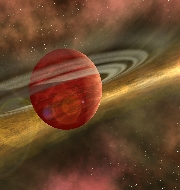Uranus may have two more moons: Study
According to study conducted by researchers from University of Idaho, US Uranus may have two tiny, previously undiscovered moons orbiting near two of the planet’s rings.
These two moons were detected by researchers after analysing decades-old images of Uranus’ icy rings taken by NASA’s Voyager 2 spacecraft which had flown by the planet 30 years ago.
What researchers have found?
- Scientists have found that the pattern in Uranus’ rings was similar to moon-related structures in Saturn’s rings called moonlet wakes.
- They have estimate the hypothesised moonlets in Uranus’ rings may be four to 14 kilometres in diameter. It means they are as small as some identified moons of Saturn.
How researchers discovered these moons?
- They had analysed decades-old images of Uranus’ icy rings taken by NASA’s Voyager 2 spacecraft which had flown by the planet 30 years ago.
- During their analysis they had noticed the amount of ring material on the edge of the alpha ring – one of the brightest of Uranus’ multiple rings – varied periodically.
- They also had found similar, even more promising pattern occurred in the same part of the neighbouring beta ring.
- They also had analysed radio occultations – made when Voyager 2 sent radio waves through the rings to be detected back on Earth.
- They also had analysed stellar occultations made when spacecraft measured light of background stars shining through the rings, which helped to show how much material they contain.
What is significance of this research?
Uranian moons are especially hard to spot because their surfaces are covered in dark material. These findings could help explain some characteristics of Uranus’ rings, which are strangely narrow compared to Saturn’s moons. It will also help to explain that if moonlets exist, they may be acting as “shepherd” moons, helping to keep the rings from spreading out. Two of Uranus’ 27 known moons, Cordelia and Ophelia act as shepherds to Uranus’ epsilon ring.
About Uranus
- Uranus is the seventh planet from the Sun. It has the third-largest planetary radius and fourth-largest planetary mass in the Solar System.
- Uranus is similar in composition to Neptune and are classified as “ice giants” to distinguish them from the gas giants.
- Its primary composition of hydrogen and helium, but it also contains more ices such as water, ammonia, and methane, along with traces of other hydrocarbons
- Every planet in our solar system except for Venus and Uranus rotates counter-clockwise as seen from above the North Pole; that is from west to east.
Month: Current Affairs - October, 2016


